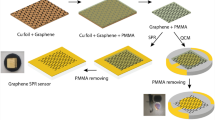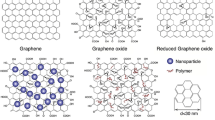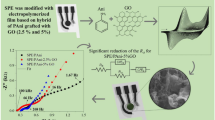Abstract
Graphene-based materials present unique properties for electrochemical applications, and laser-induced conversion of polyimide to graphene is an emerging route to obtain a high-quality material for sensing. Herein we present compact and low-cost equipment constructed from an open-source 3D printer at which a 3.5-W visible (449 nm) laser was adapted to fabricate laser-induced graphene (LIG) electrodes from commercial polyimide, which resulted in electron transfer kinetic (k0) of 5.6 × 10−3 cm s−1 and reproducibility calculated by relative standard deviation (RSD < 5%) from cyclic voltammograms of [Fe(CN)6]3−/4− using 5 different electrodes. LIG electrodes enabled the simultaneous voltammetric determination of uric acid (+ 0.1 V vs. pseudo-reference) and nitrite (+ 0.4 V vs pseudo-reference), with limit of detection (LOD) values of 0.07 and 0.27 µmol L−1, respectively. Amperometric measurements for the detection of H2O2 (applying + 0.0 V vs. Ag|AgCl|KCl(sat.)) after Prussian blue (PB) modification and ciprofloxacin (applying + 1.2 V vs. Ag|AgCl|KCl(sat.)) were performed under flow conditions, which confirmed the high stability of LIG and LIG-PB surfaces. The LOD values were 1.0 and 0.2 µmol L−1 for H2O2 and ciprofloxacin, respectively. The RSD values (< 12%) obtained for the analysis using three different electrodes attested the precision of LIG electrodes manufactured in two designs. No sample matrix effects on the determination of ciprofloxacin in milk samples were observed (recoveries between 84 and 96%). The equipment can be built with less than $300 and each LIG electrode costs less than $0.01.
Graphical abstract






Similar content being viewed by others
References
Brownson DAC, Banks CE (2010) Graphene electrochemistry: an overview of potential applications. Analyst 135:2768. https://doi.org/10.1039/c0an00590h
Brownson DAC, Kampouris DK, Banks CE (2012) Graphene electrochemistry: fundamental concepts through to prominent applications. Chem Soc Rev 41:6944–6976. https://doi.org/10.1039/c2cs35105f
Novoselov KS, Geim AK, Morozov S V et al (2004) Electric field in atomically thin carbon films. Science 306:666–669. https://doi.org/10.1126/science.1102896
Lin J, Peng Z, Liu Y et al (2014) Laser-induced porous graphene films from commercial polymers. Nat Commun 5:5–12. https://doi.org/10.1038/ncomms6714
da Silva FD, Rocha RG, Rocha DP et al (2020) In situ electrochemical exfoliation of embedded graphite to superficial graphene sheets for electroanalytical purposes. Electrochim Acta 354:136762. https://doi.org/10.1016/j.electacta.2020.136762
Bláha M, Bouša M, Valeš V et al (2021) Two-dimensional CVD-graphene/polyaniline supercapacitors: synthesis strategy and electrochemical operation. ACS Appl Mater Interfaces 13:34686–34695. https://doi.org/10.1021/acsami.1c05054
Chua CK, Pumera M (2014) Chemical reduction of graphene oxide: a synthetic chemistry viewpoint. Chem Soc Rev 43:291–312. https://doi.org/10.1039/C3CS60303B
Muzyka K, Xu G (2021) Laser-induced graphene in facts, numbers, and notes in view of electroanalytical applications: a review. Electroanalysis 34:574–589. https://doi.org/10.1002/elan.202100425
Pereira SO, Santos NF, Carvalho AF, et al (2021) Electrochemical response of glucose oxidase adsorbed on laser-induced graphene. Nanomaterials 11:1893 https://doi.org/10.3390/nano11081893
Singh SP, Li Y, Be’Er A et al (2017) Laser-induced graphene layers and electrodes prevents microbial fouling and exerts antimicrobial action. ACS Appl Mater Interfaces 9:18238–18247. https://doi.org/10.1021/acsami.7b04863
Iacopino D, Vaughan E, Larrigy C et al (2020) Visible laser scribing fabrication of porous graphitic carbon electrodes: morphologies, electrochemical properties, and applications as disposable sensor platforms. ACS Appl Electron Mater 2:3279–3288. https://doi.org/10.1021/acsaelm.0c00612
Cardoso AR, Marques AC, Santos L et al (2019) Molecularly-imprinted chloramphenicol sensor with laser-induced graphene electrodes. Biosens Bioelectron 124–125:167–175. https://doi.org/10.1016/j.bios.2018.10.015
Behrent A, Griesche C, Sippel P, Baeumner AJ (2021) Process-property correlations in laser-induced graphene electrodes for electrochemical sensing. Microchim Acta 188:159. https://doi.org/10.1007/s00604-021-04792-3
Liu J, Ji H, Lv X et al (2022) Laser-induced graphene (LIG)-driven medical sensors for health monitoring and diseases diagnosis. Microchim Acta 189:54. https://doi.org/10.1007/s00604-021-05157-6
Santos NF, Pereira SO, Moreira A et al (2021) IR and UV laser-induced graphene: application as dopamine electrochemical sensors. Adv Mater Technol 6:2100007. https://doi.org/10.1002/admt.202100007
Nasraoui S, Al-Hamry A, Teixeira PR et al (2021) Electrochemical sensor for nitrite detection in water samples using flexible laser-induced graphene electrodes functionalized by CNT decorated by Au nanoparticles. J Electroanal Chem 880:114893. https://doi.org/10.1016/j.jelechem.2020.114893
Soares RRA, Hjort RG, Pola CC et al (2020) Laser-induced graphene electrochemical immunosensors for rapid and label-free monitoring of Salmonella enterica in chicken broth. ACS Sensors 5:1900–1911. https://doi.org/10.1021/acssensors.9b02345
Andriianov VS, Mironov VS, Smikhovskaia AV et al (2020) Laser-induced synthesis of carbon-based electrode materials for non-enzymatic glucose detection. Opt Quantum Electron 52:1–8. https://doi.org/10.1007/s11082-019-2155-7
Zhu B, Yu L, Beikzadeh S et al (2021) Disposable and portable gold nanoparticles modified - laser-scribed graphene sensing strips for electrochemical, non-enzymatic detection of glucose. Electrochim Acta 378:138132. https://doi.org/10.1016/j.electacta.2021.138132
Johnson ZT, Williams K, Chen B et al (2021) Electrochemical sensing of neonicotinoids using laser-induced graphene. ACS Sensors 6:3063–3071. https://doi.org/10.1021/acssensors.1c01082
Yagati AK, Behrent A, Beck S et al (2020) Laser-induced graphene interdigitated electrodes for label-free or nanolabel-enhanced highly sensitive capacitive aptamer-based biosensors. Biosens Bioelectron 164:112272. https://doi.org/10.1016/j.bios.2020.112272
Settu K, Chiu P-T, Huang Y-M (2021) Laser-induced graphene-based enzymatic biosensor for glucose detection. Polymers (Basel) 13:2795. https://doi.org/10.3390/polym13162795
Liu JM (1982) Simple technique for measurements of pulsed Gaussian-beam spot sizes. Opt Lett 7:196. https://doi.org/10.1364/OL.7.000196
Katic V, dos Santos PL, dos Santos MF et al (2019) 3D printed graphene electrodes modified with Prussian blue: emerging electrochemical sensing platform for peroxide detection. ACS Appl Mater Interfaces 11:35068–35078. https://doi.org/10.1021/acsami.9b09305
Karyakin AA, Karyakina EE (1999) Prussian blue-based 'artificial peroxidase’ as a transducer for hydrogen peroxide detection. Application to biosensors. Sensors Actuators B Chem 57:268–273. https://doi.org/10.1016/S0925-4005(99)00154-9
Cardoso RM, Mendonça DMH, Silva WP et al (2018) 3D printing for electroanalysis: from multiuse electrochemical cells to sensors. Anal Chim Acta 1033:49–57. https://doi.org/10.1016/J.ACA.2018.06.021
Romero FJ, Salinas-Castillo A, Rivadeneyra A et al (2018) In-depth study of laser diode ablation of Kapton polyimide for flexible conductive substrates. Nanomaterials 8:517. https://doi.org/10.3390/nano8070517
Settu K, Lai Y-C, Liao C-T (2021) Carbon nanotube modified laser-induced graphene electrode for hydrogen peroxide sensing. Mater Lett 300:130106. https://doi.org/10.1016/j.matlet.2021.130106
Xu G, Jarjes ZA, Desprez V et al (2018) Sensitive, selective, disposable electrochemical dopamine sensor based on PEDOT-modified laser scribed graphene. Biosens Bioelectron 107:184–191. https://doi.org/10.1016/j.bios.2018.02.031
Aikens DA (1983) Electrochemical methods, fundamentals and applications. J Chem Educ 60:A25. https://doi.org/10.1021/ed060pA25.1
Freitas JM, Oliveira T da C, Munoz RAA, Richter EM (2019) Boron doped diamond electrodes in flow-based systems. Front Chem 7:190. https://doi.org/10.3389/fchem.2019.00190
Shoukat R, Khan MI (2021) Carbon nanotubes: a review on properties, synthesis methods and applications in micro and nanotechnology. Microsyst Technol 27:4183–4192. https://doi.org/10.1007/s00542-021-05211-6
Mocak J, Bond AM, Mitchell S, Scollary G (1997) A statistical overview of standard (IUPAC and ACS) and new procedures for determining the limits of detection and quantification: application to voltammetric and strip** techniques (technical report). Pure Appl Chem 69:297–328
O’Halloran MP, Pravda M, Guilbault GG (2001) Prussian blue bulk modified screen-printed electrodes for H2O2 detection and for biosensors. Talanta 55:605–611. https://doi.org/10.1016/S0039-9140(01)00469-6
Zhang Y, Sun X, Zhu L et al (2011) Electrochemical sensing based on graphene oxide/Prussian blue hybrid film modified electrode. Electrochim Acta 56:1239–1245. https://doi.org/10.1016/j.electacta.2010.11.011
de Faria LV, Lisboa TP, Campos NS et al (2021) Electrochemical methods for the determination of antibiotic residues in milk: a critical review. Anal Chim Acta 1173:338569. https://doi.org/10.1016/j.aca.2021.338569
Yuan Y, Zhang F, Wang H et al (2018) A sensor based on Au nanoparticles/carbon nitride/graphene composites for the detection of chloramphenicol and ciprofloxacin. ECS J Solid State Sci Technol 7:M201–M208. https://doi.org/10.1149/2.0111812jss
Rocha DP, Cardoso RM, Tormin TF et al (2018) Batch-injection analysis better than ever: new materials for improved electrochemical detection and on-site applications. Electroanalysis 30:1386–1399. https://doi.org/10.1002/elan.201800042
Acknowledgements
The authors are grateful to the Multiuser laboratory of the Institute of Chemistry and to Murillo Silva for obtaining the SEM images, and to the Multiuser laboratory at the Institute of Physics for Raman experiments (equipment provided by CAPES supported by the “Pró-Equipamentos” grant).
Funding
This work was financed by Brazilian agencies FAPEMIG (RED-00042–16 and APQ-03141–18), CAPES (001), CNPq (427731/2018–6, 307271/2017–0, 315838/2021–3, and 163330/2020–4), and INCTBio (CNPq grant no. 465389/2014–7).
Author information
Authors and Affiliations
Corresponding author
Ethics declarations
Conflict of interest
The authors declare no competing interests.
Additional information
Publisher's note
Springer Nature remains neutral with regard to jurisdictional claims in published maps and institutional affiliations.
Supplementary Information
Below is the link to the electronic supplementary material.
Rights and permissions
About this article
Cite this article
Costa, W.R.P., Rocha, R.G., de Faria, L.V. et al. Affordable equipment to fabricate laser-induced graphene electrodes for portable electrochemical sensing. Microchim Acta 189, 185 (2022). https://doi.org/10.1007/s00604-022-05294-6
Received:
Accepted:
Published:
DOI: https://doi.org/10.1007/s00604-022-05294-6




